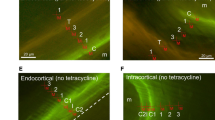Summary
Parathyroid hormone (PTH) induces osteoblastlike cells to secrete factors capable of increasing cellular bone resorption; these factors are extremely labile. We have partially isolated them from supernatants of PTH-stimulated ROS 17.2 cells using affinity chromatography. Products eluted from the matrix, carboxymethyl cellulose covalently linked to Cibacron Blue F3GA, (CM-AB) were used as immunogens in mice. Serum from these mice blocked the effect of PTH-stimulated supernatants in a bioassay for bone resorption (the bone rudiment system). Then, hybridomas were produced from spleen cells of these mice. Screening of these hybridoma cultures revealed a consistent blocking effect of supernatants at a dilution of 1:100 in the bioassay. At higher dilution (1:1000), however, fewer culture supernatants blocked this effect in the bioassay. Mixed hybridoma cultures have been cloned and subcloned. Evaluation of the resulting hybridoma supernatants revealed that supernatants from at least three clones were necessary to neutralize the effect of the PTH-induced, osteoblast-produced resorption factors in organ culture. Similarly, using sucrose density gradient analysis, it is necessary to use three antibodies to bind all the 35S-labeled protein from supernatants of PTH-stimulated ROS cultures (equivalent to the fraction used as immunogen in the mice). The effect of PTH in organ culture is blocked by this same group of hybridoma supernatants. The antibodies appear specific for osteoblast-like cell resorption factors, as they do not block the effect of PTH on cAMP accumulation in ROS cell cultures. On the other hand, they do block the effects of dibutyral cAMP on resorption in organ culture. The effect of antibodies on bone resorption is not nonspecific, as hybridomas have no effect on increased 45Ca release from organ culture induced by thyroxine. We conclude that we have isolated hybridomas that produce antibodies capable of binding to PTH-induced, osteoblast-produced factors. These antibodies are able to inhibit the increase in cellular bone resorption in organ cultures caused to either PTH or these factors.
Similar content being viewed by others
References
Rodan, GA, Martin TJ (1981) The role of osteoblasts in hormonal control of bone resorption: a hypothesis. Calcif Tissue Int 33:349
Perry HM, Skogen W, Chappel JC, Wilner GD, Kahn AJ, Teitelbaum SL (1988) Conditioned medium from osteoblast-like cells mediate parathyroid hormone induced bone resorption. Calcif Tissue Int 40:298
McSheehy PMJ, Chamber TJ (1986) Osteoblast cells mediate osteoclastic responsiveness to parathyroid hormone. Endocrinology 118:824
Wong GL (1984) Paracrine interactions in bone secreted products of osteoblasts permit osteoclasts to respond to parathyroid hormone. J Biol Chem 259:4019
Braidman IP, St. John JG, Anderson DC, Robertson WR (1986) Effects of physiologic concentrations of parathyroid hormone on acid phosphatase activity in cultured rat bone cells. J Endocrinology 111:17
Fallon MF (1983) Osteoblasts mediate osteoclastic bone resorption in cell culture. Calcif Tissue Int 33:640
Perry HM, Skogen W, Chappel J, Kahn AJ, Wilner G, Teitelbaum SL (1989) Partial characterization of a parathyroid hormone stimulated resorption factor from osteoblast-like cells. Endocrinology 125–2075
McSheehy PMJ, Chambers TJ (1986) Osteoblast-like cells in the presence of parathyroid hormone release soluble factor that stimulates osteoclastic bone resorption. Endocrinology 119:1654
Chamber TJ (1987) Cellular and hormonal interactions in bone resorption in calcium regulation and bone metabolism. In: Cohn DV, Martin TJ, Meunier PJ (eds) Basic and clinical aspects, vol. 9. Elsevier, New York, p 335
Raisz LG, Neiman I (1969) Effect of phosphate calcium and magnesium on bone resorption and hormonal responses in tissue culture. Endocrinology 85:446
Pernalete N, Garcia JC, Betts CR, Martin KJ (1990) Inhibitors of protein kinase C modulate desensitization of the parathyroid hormone receptor. Adenylate cyclase system in opposing kidney cells. Endocrinology 126:407
Perry HM, Kahn AJ, Chappel JC, Kohler G, Teitelbaum SL, Peck WA (1983) Calcitonin response in circulating human lymphocyte. Endocrinology 113:1568
Dean PDG, Watson DH (1979) Protein purification using immobilized triazine dyes. J Chromatogr 165:301
Zola H, Brooks D (1982) Techniques for the production and characterization of monoclonal hybridoma antibodies. In: Hurrell JGR (ed) Monoclonal hybridoma antibodies, techniques and application. CRC Press, Boca Raton, p 1
Stahli C, Stoehlin T, Miggiano V, Schmidt J, Herring P (1980) High frequencies of antigen-specific hybridomas: dependence on immunization parameters and prediction by spleen cell analysis. J Immunol Methods 32:297
Fazekas de St. Giroth, Scheidegger D (1980) Production of monoclonal antibodies: strategy and tactics. J Immunol Methods 35:1
Watson DH, Harvey MJ, Dean PDG (1978) The selective retardation of NADP+ dependent dehydrogenases by immobilized Procion Red HE-3B. Biochem J 173:591
Scawen MD, Darkyshiri J, Harvey MJ, Atkinson T (1982) The rapid purification of 3-hydroxybutyrate dehydrogenase and malate dehydrogenase on triazine dye affinity matrices. Biochem J 203:699
McSheehy PMJ, Chambers TJ (1987) 1,25 dihydroxyvitamin D3 stimulates rat osteoblastic cells to release a soluble factor that increases osteoclastic bone resorption. J Clin Invest 80:425
Thomson BM, Mundy GR, Chambers TJ (1987) Tumor necrosis factors x and B induce osteoblastic cells to stimulate osteoclastic bone resorption. J Immunol 138:775
Bertolini DR, Nedwin GE, Bringham TS, Smith DD, Mundy GR (1986) Stimulation of bone resorption and inhibition of bone formation in vitro by human tumor necrosis factors. Nature 319:516
Author information
Authors and Affiliations
Rights and permissions
About this article
Cite this article
Perry, H.M., Gurbani, S. Development of monoclonal antibodies to parathyroid hormone-induced resorptive factors from osteoblast-like cells. Calcif Tissue Int 50, 237–244 (1992). https://doi.org/10.1007/BF00296288
Received:
Revised:
Issue Date:
DOI: https://doi.org/10.1007/BF00296288



